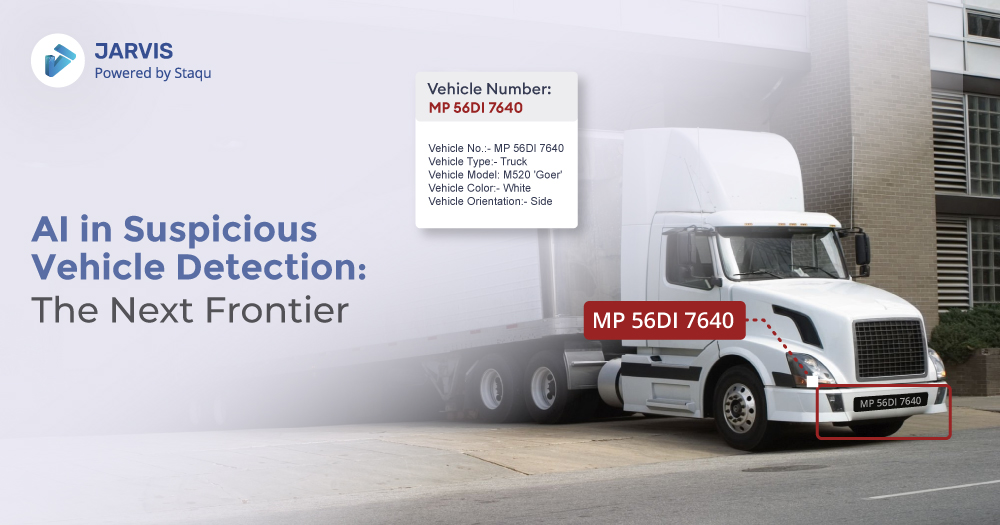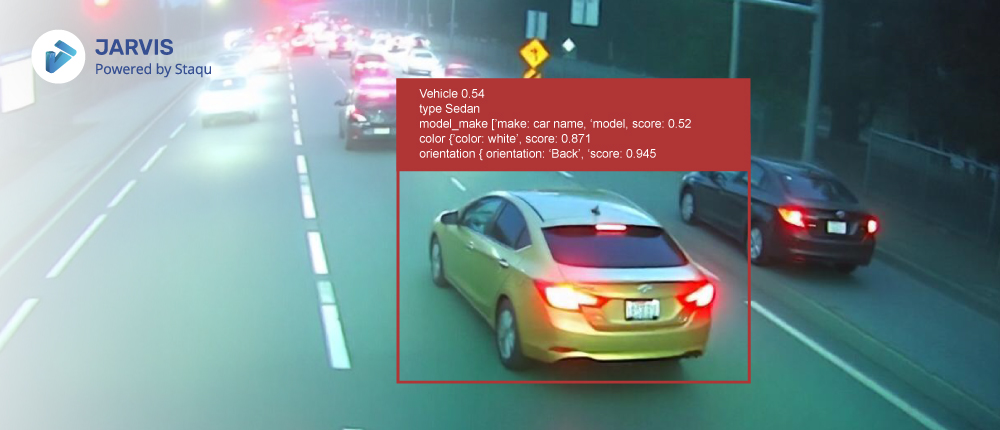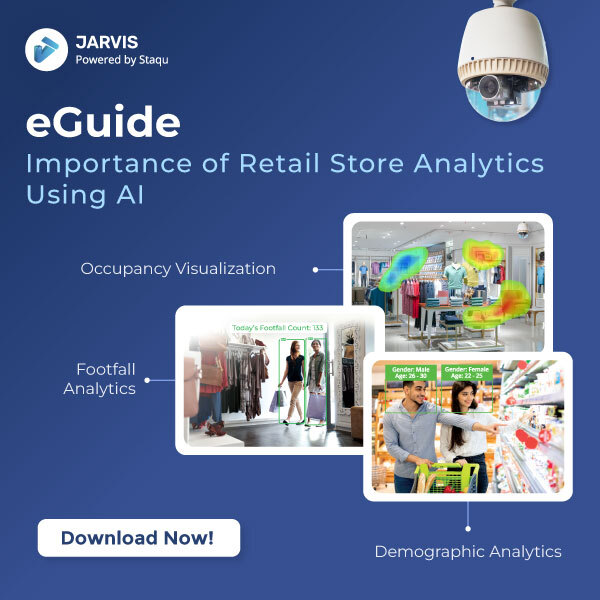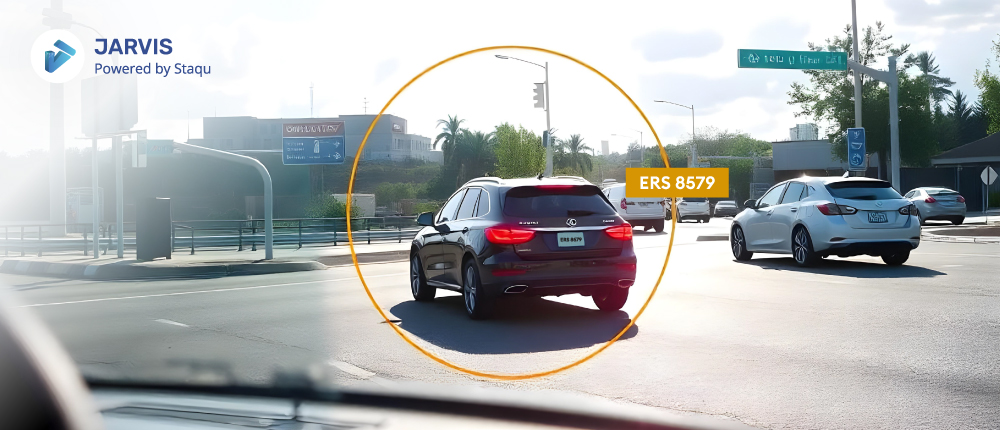AI in Suspicious Vehicle Detection: The Next Frontier

As technology advanced, vehicle detection methods evolved. Basic camera systems and license plate recognition software marked improvements but faced challenges like lighting conditions, plate designs, and the need for constant human monitoring. The true revolution came with AI. Machine learning, computer vision, and real-time analytics brought a new level of sophistication, enabling systems to detect suspicious activity with greater accuracy and speed.In an era where every moment counts, relying on traditional security is no longer enough. Urbanization and complex public spaces demand quick, accurate threat detection. Vehicle detection is crucial in modern security, but as threats evolve, so must our technology. Enter Artificial Intelligence (AI)—a game-changer in suspicious vehicle detection.
AI-powered solutions like Jarvis are revolutionizing vehicle surveillance. These systems enhance the accuracy and efficiency of detecting suspicious vehicles while offering real-time responses to prevent incidents. This blog explores how AI, particularly through Jarvis, is transforming suspicious vehicle detection and leading the next frontier in security.
Evolution of Suspicious Vehicle Detection
History
Suspicious vehicle detection has always been a crucial element of security, particularly in urban areas where traffic is dense, and the risk of incidents is higher. Traditionally, this task was handled by manual surveillance—security personnel monitoring live footage from CCTV cameras or physically patrolling areas. While effective to some degree, these methods are fraught with limitations, including human error, delayed response times, and the sheer volume of data that must be processed.
Rise of AI
As technology advanced, vehicle detection methods evolved. Basic camera systems and license plate recognition software marked improvements but faced challenges like lighting conditions, plate designs, and the need for constant human monitoring. The true revolution came with AI. Machine learning, computer vision, and real-time analytics brought a new level of sophistication, enabling systems to detect suspicious activity with greater accuracy and speed.
Introduction to Jarvis
Jarvis has emerged as a leading solution in AI-driven vehicle detection. It overcomes traditional system limitations by integrating advanced AI technologies, offering unmatched accuracy and efficiency. Whether in urban environments, retail lots, or critical infrastructure, Jarvis sets a new standard for security.
How AI Enhances Suspicious Vehicle Detection
AI Capabilities
AI-driven vehicle detection relies on key technologies. Machine learning helps systems learn from data, improving their ability to recognize patterns and anomalies. Computer vision analyzes visual data to identify vehicle features, behaviors, or movements that may signal a threat. Real-time analytics processes this data instantly, enabling swift responses to risks.
Jarvis’s AI Integration
Jarvis enhances every aspect of vehicle detection by analyzing thousands of data points in real-time. It distinguishes between normal and suspicious behavior with increasing accuracy, thanks to machine learning. Computer vision enables precise identification of vehicles based on attributes like license plate numbers, make, model, and color.
Benefits
AI in vehicle detection offers numerous benefits. Reduced false positives allow security teams to focus on real threats. Faster response times enable immediate action, preventing incidents from escalating. Predictive analytics can even forecast threats based on historical data, allowing for preemptive measures.
Role of ANPR in AI-Driven Vehicle Detection
Understanding ANPR
Automatic Number Plate Recognition (ANPR) is a technology that automatically reads and records the license plates of vehicles. It’s a cornerstone of modern vehicle detection systems, used widely in law enforcement, toll collection, and parking management. ANPR systems use optical character recognition (OCR) to convert images of license plates into readable data. However, traditional ANPR systems are often limited to just reading license plates, missing out on other critical vehicle attributes that could be vital in identifying suspicious activity.
Jarvis’s ANPR with Attribute Search
Jarvis elevates ANPR by integrating it with attribute search capabilities. Besides reading license plates, Jarvis ANPR analyzes vehicle attributes like color, make, model, and custom modifications. This ensures accurate identification even if a license plate is obscured or altered, significantly enhancing real-time tracking of suspicious vehicles.

Real-World Applications
Jarvis’s ANPR with attribute search offers vast applications. Law enforcement can track stolen vehicles or those involved in criminal activities. In retail environments, Jarvis monitors parking lots for flagged vehicles, enhancing security for customers and staff. Toll collection systems also benefit from reduced fraud as Jarvis accurately identifies vehicles, even when attempts are made to alter or obscure license plates.

Download eguide
Real-Time Suspicious Vehicle Alerts with AI
The Need for Speed
In the world of security, time is of the essence. The ability to detect a suspicious vehicle in real time and respond immediately can be the difference between preventing a crime and dealing with its aftermath. Traditional surveillance systems often fall short in this regard, as they rely heavily on manual monitoring and delayed data processing.
Jarvis’s Real-Time Capabilities
Jarvis excels in delivering real-time suspicious vehicle alerts. By harnessing the power of AI and machine learning, Jarvis processes data as it is collected, instantly identifying any anomalies or threats. This allows security teams to respond within seconds, whether it’s dispatching law enforcement, locking down an area, or simply tracking the vehicle’s movements until it can be intercepted.
Case Study/Scenario
Imagine a scenario where a vehicle flagged in a national crime database enters a busy shopping mall’s parking lot. With traditional systems, security might not be alerted until it’s too late. However, with Jarvis, the vehicle’s license plate is immediately recognized, and its other attributes are cross-referenced in real time. An alert is sent to the mall’s security team, who can then take swift action to apprehend the suspect before they can pose a threat to shoppers.
Overcoming Challenges in AI-Based Vehicle Detection
Technical Challenges
While AI offers significant advantages in vehicle detection, it’s not without its challenges. Environmental factors, such as poor lighting, extreme weather conditions, or heavy traffic, can affect the accuracy of detection. Variations in license plate designs across different regions also pose a challenge, as does the need to balance security with data privacy concerns.
How Jarvis Addresses These Challenges
Jarvis is designed with these challenges in mind. Its AI algorithms are trained on diverse datasets which provides around 10-60 FPS, ensuring they perform well under a wide range of conditions. Advanced image processing techniques help mitigate the effects of poor lighting or adverse weather. Furthermore, Jarvis’s ability to cross-reference multiple vehicle attributes reduces reliance on license plates alone, increasing the accuracy of detection even when plates are altered or obscured.
Future-Proofing with Jarvis
As threats evolve, so too must the technology used to combat them. Jarvis is built to be adaptable, with regular updates to its AI algorithms and the ability to integrate with new technologies as they emerge. This ensures that Jarvis remains at the cutting edge of suspicious vehicle detection, capable of meeting future challenges head-on.
The Future of AI in Suspicious Vehicle Detection
Emerging Trends
The field of AI in vehicle detection is rapidly evolving, with several trends set to shape its future. One of the most significant is the integration of AI with smart city infrastructure. As cities become more connected, AI-driven vehicle detection systems like Jarvis will play a crucial role in managing traffic, preventing crime, and enhancing public safety. Another trend is the development of autonomous vehicles, which will require even more sophisticated detection systems to monitor their movements and ensure they comply with laws and regulations.
Jarvis’s Role in the Future
Jarvis is positioned to be a leader in these emerging trends. Its scalable architecture allows it to integrate seamlessly with smart city platforms, providing real-time data that can be used to manage everything from traffic flow to emergency response. As autonomous vehicles become more common, Jarvis’s advanced AI capabilities will be essential in monitoring these vehicles, ensuring they operate safely and securely.
Impact on Security Industries
The advancements in AI-driven vehicle detection will have far-reaching impacts on various security industries. Law enforcement agencies will benefit from more efficient tracking and identification of criminal vehicles, reducing the time and resources needed for investigations. In the private sector, businesses will be able to offer their customers and employees a safer environment, while also protecting their assets more effectively. Ultimately, the widespread adoption of AI-driven vehicle detection systems like Jarvis will lead to a safer, more secure world.
Ethical Considerations and Privacy Concerns
Balancing Security and Privacy
As with any surveillance technology, the use of AI in vehicle detection raises important ethical questions, particularly around privacy. While the ability to monitor and track vehicles in real-time is invaluable for security, it also has the potential to infringe on individuals’ privacy rights. This is particularly concerning in public spaces, where people expect a certain level of anonymity.
Jarvis’s Commitment to Privacy
Jarvis balances security needs with protecting individual privacy. The system complies with all relevant data protection laws and regulations, handling personal information with the utmost care. Additionally, Jarvis employs anonymization techniques to use data solely for enhancing security without infringing on personal privacy.
Responsible AI Usage
Using AI responsibly is crucial for maintaining public trust. Jarvis leads by example in the industry, using its AI-driven vehicle detection systems ethically and transparently. The company regularly audits its data handling practices and clearly communicates with users about how it uses and protects their data.
Conclusion
AI integration in vehicle detection marks the next frontier in security. Tools like Jarvis bring a new level of efficiency, accuracy, and real-time responsiveness to surveillance. By leveraging AI, Jarvis enhances detection while addressing challenges and ethical concerns associated with this technology.
As we move forward, AI-driven solutions will play a vital role in ensuring community safety. With advanced AI integration, real-time capabilities, and a commitment to ethical use, Jarvis is set to lead this transformation. For those seeking to improve security operations, exploring Jarvis isn’t just an option—it’s essential.

